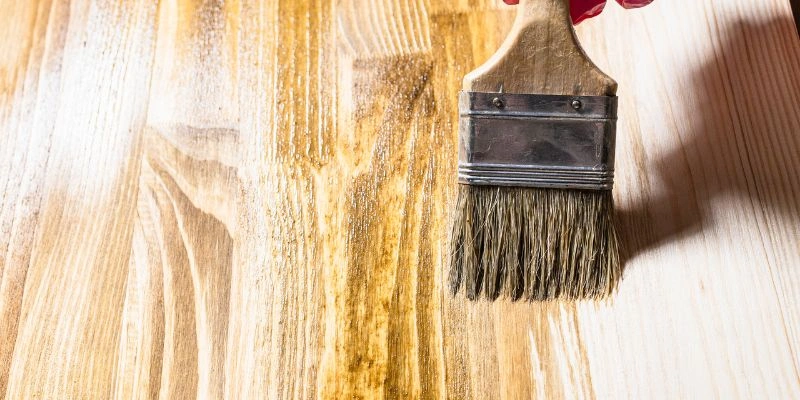Yes, you can stain rubberwood. Choose a compatible wood stain to achieve your desired finish.
Rubberwood, also known as parawood, is a popular choice for furniture and cabinetry due to its durability and eco-friendliness. This hardwood is sourced from the rubber tree, primarily used for latex production. After its productive life, the wood is repurposed, making it an environmentally responsible option.
Staining rubberwood enhances its natural beauty and allows for customization in color. Since rubberwood has a light color and fine grain, it readily accepts stains, providing a smooth finish. Understanding the best practices for staining this wood can help you achieve professional-looking results, whether for a DIY project or furniture restoration.
Introduction To Rubberwood
Rubberwood is a type of hardwood from the rubber tree. It is known for its durability and sustainability. After the tree stops producing latex, it can be used for lumber.
What is Rubberwood? Rubberwood has a light color and fine grain. It is easy to work with and can be stained or painted. This makes it a popular choice for many furniture designs.
Common Uses of Rubberwood include:
- Furniture, like tables and chairs
- Cabinets and shelves
- Flooring and decorative items
- Toys and crafts
Myths And Misconceptions
Many people believe rubberwood is not durable. This is not true. Rubberwood is strong and can last a long time. It can handle daily use well.
Some think rubberwood is too soft for heavy items. In reality, it is harder than many other common woods. This makes it a great choice for furniture.
Others worry about staining rubberwood. With the right products, it can take stains beautifully. Many find that the wood absorbs colors evenly.
Understanding these common misunderstandings helps in making better choices. Rubberwood is a reliable option for various uses.

The Staining Process
Proper preparation is key before staining rubberwood. First, clean the surface thoroughly. Remove all dust and dirt using a damp cloth.
Next, allow the wood to dry completely. This step prevents any moisture from affecting the stain. Sand the surface lightly with fine-grit sandpaper. This helps the stain to adhere better.
Choosing the right stain is essential. Oil-based stains work well on rubberwood. They offer a rich color and deep finish. Water-based stains dry faster but may raise the wood grain.
Test the stain on a small area first. This ensures the desired color and finish. Always follow the manufacturer’s instructions for the best results.
Benefits Of Staining Rubberwood
Staining rubberwood can greatly improve its appearance. A rich stain adds depth and color. This makes furniture look more appealing and stylish.
Staining also offers protection against wear and tear. A good stain creates a barrier against moisture and dirt. This helps to keep rubberwood looking new for a longer time.
Using stain can also enhance the natural grain of rubberwood. This highlights its unique features. A well-stained piece can become a focal point in any room.
Potential Challenges
Rubberwood has a unique wood grain. Staining it can be tricky. Different parts of the wood may absorb stain unevenly.
This can lead to a patchy appearance. Proper preparation is key. Sanding the surface well helps with even stain application.
Stain adhesion can be a problem. Using a wood conditioner before staining can improve results. This step helps the stain soak in evenly.
Choosing the right stain is also important. Some stains work better than others on rubberwood. Testing on a small piece first is a smart idea.
Expert Tips For Perfect Results
Proper sanding is key for great results on rubberwood. Start with a coarse grit sandpaper to remove any imperfections. Gradually move to finer grits for a smooth finish. Always sand in the direction of the grain. This helps avoid scratches and ensures even application.
For application methods, choose between brushes, rags, or sprayers. Brushes are great for detailed areas. Rags are perfect for wiping on stains quickly. Sprayers offer an even coat but require practice. Always test your method on a small area first.
Stain Selection Guide
Choosing the right stain for rubberwood is important. Different types of stains can affect the final look. Consider oil-based, water-based, and gel stains. Each type has unique properties.
Oil-based stains provide rich color and durability. They take longer to dry but last longer. Water-based stains dry quickly and have low odor. They are easy to clean up. Gel stains sit on top of the wood, allowing for even color.
Color is a key factor in stain selection. Light stains can highlight the wood’s natural beauty. Darker stains create a more dramatic effect. Test a small area before committing to a color.
| Stain Type | Drying Time | Durability |
|---|---|---|
| Oil-based | Slow | High |
| Water-based | Fast | Medium |
| Gel | Medium | Medium |
Real-world Examples
Staining rubberwood can greatly enhance its appearance. Many homeowners have achieved stunning results.
Before staining, rubberwood often looks light and plain. After applying a rich stain, it can appear warm and inviting.
Case Study 1: A light walnut stain transformed a simple rubberwood table. It became a beautiful centerpiece in the dining room.
Case Study 2: A dark mahogany stain added depth to rubberwood cabinets. These cabinets now look elegant and luxurious.
Before and After examples show how stain can create a dramatic change. The right stain brings out the natural beauty of rubberwood.

Frequently Asked Questions
Can You Stain Rubberwood Successfully?
Yes, you can stain rubberwood. It’s important to prepare the wood properly before staining. Sand the surface to create a smooth finish. Use a pre-stain conditioner to ensure even color absorption. Choose a suitable stain for the best results, and apply it with a brush or cloth.
What Is The Best Stain For Rubberwood?
The best stains for rubberwood are oil-based or water-based. Oil-based stains penetrate deeply, enhancing the wood’s natural grain. Water-based stains dry quickly and are easy to clean. Test the stain on a small area first to see how it looks before applying it to the entire piece.
How Do You Prepare Rubberwood For Staining?
To prepare rubberwood for staining, start by cleaning the surface. Remove dust and debris with a damp cloth. Sand the wood using fine-grit sandpaper to achieve a smooth finish. Apply a pre-stain conditioner to promote even stain absorption and prevent blotchiness.
Is Rubberwood Suitable For Furniture?
Yes, rubberwood is highly suitable for furniture. It’s durable, affordable, and has a beautiful grain. Additionally, rubberwood is eco-friendly as it comes from sustainable sources. With proper care, rubberwood furniture can last for years, making it a great choice for various styles and settings.
Conclusion
Staining rubberwood is entirely possible and can enhance its natural beauty. Choose the right stain for the best results. Always test a small area first to see how the wood reacts. With proper preparation and care, your rubberwood pieces can achieve a stunning finish that complements any decor.

